Power delivery over single twisted pair Ethernet
Originally developed at Xerox PARC in the 1970s, Ethernet has come a long way since its ratification as the IEEE 802.3 standard in 1983. It has evolved to support increasingly faster networks, more nodes, and longer distances while retaining backward compatibility with previous versions.
Ethernet was initially aimed at network applications for information technology (IT)-based desktop computer and data centre systems. Its widespread adoption has also meant a reduction in costs due to economies of scale, making it an affordable, widely available solution, replacing legacy network technologies in many areas. It wasn’t long before its resilience and reliability led Ethernet out of IT to many other operational technology (OT) applications, including telecoms infrastructure, building automation, and industrial applications. But the expanse of Ethernet technology has not stopped there, being deployed in many automotive, aerospace, and robotics applications as well.
With faster speeds, Ethernet has now become a widely used networking method for industrial automation equipment, with growing interest in process automation. However, its use has been restricted by physical issues due to the standard Cat 5 and Cat 6 cabling. This type of cable uses four twisted pairs, and the resulting size, weight, and limited bending radius can be a problem for engineers – especially for installations within vehicles or robotic automations, where these factors are critical to the design.
To overcome these problems, single-pair Ethernet (SPE) has been developed. As the name suggests, SPE uses just one twisted pair of copper wires. As well as overcoming physical cabling challenges, SPE expands the potential for many new applications, due to its ability to deliver power as well as carry data. With no separate power cabling required, this reduces installation and maintenance costs and increases flexibility by making it easier to locate devices away from power outlets.
Within this article, Mark Patrick, Mouser Electronics explores SPE and the benefits it can provide, as well as looks at additional functionality such as power delivery across the same twisted pair used for data transfer, also known as power over data line (PoDL) and single-pair power over Ethernet (SPoE).
SPE solves physical challenges of Cat 5 and Cat 6 cabling
SPE is defined by the IEEE 802.3cg standard, introduced in 2019, which supports speeds of up to 10Mb/s. This means it is faster than some well-established legacy standards. For example, controller area network (CAN), commonly used in vehicles, only supports up to about 1Mb/s. This is plenty for CAN’s traditional automotive uses – such as sending signals to operate signals or locks – but not fast enough to carry video data from in-car cameras or radar sensors.
The 802.3cg standard defines two physical layer (PHY) protocols, aimed at different use cases:
- 10BASE-T1L enables point-to-point Ethernet links of up to 1,000m, with power delivery available as an option
- 10BASE-T1S point-to-point transmission supports 10MB/s at distances of up to 15m. Half-duplex multidrop communication is supported at 10Mb/s up to 25m
10BASE-T1S is a good choice for shorter distances and locations where there may be high levels of noise (such as automotive applications), while 10BASE-T1L provides the range needed for large factories or buildings (Figure 1). Both variants have also found applications in the Industrial Internet of Things (IIoT).
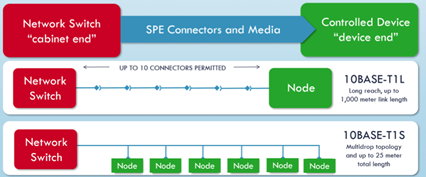
Figure 1: SPE-based networking. (Source: Ethernet Alliance, https://ethernetalliance.org/wp-content/uploads/2020/08/EA_TechBrief-SPE-OT_final.pdf)
SPE has enabled Ethernet's reach to expand from the office and the data centre to the Industrial Internet of Things (IIoT) and to serve a broad range of OT uses. Connecting devices directly to the cloud can remove substantial cost and complexity from production plants that might have hundreds or even thousands of sensors and actuators that previously would have needed gateways or interface peripherals of some sort.
As the twisted pair used by SPE can besmaller and lighter than Cat 5 and Cat 6 cabling and its traditional four twisted pairs, it is better suited to industrial and automotive applications with space constraints or where there are strict system weight targets.
Looking ahead, higher data rates have already been defined for SPE, with IEEE standards already ratified or in development taking data rates up to 1Gb/s and beyond.
Power delivery accelerates SPE adoption
As well as overcoming physical cabling challenges, SPE expands the potential for many new applications, allowing for power delivery and data transfer over a single pair of wires. For example, in office environments, delivering power over Ethernet data cabling is often much simpler and cheaper than running dedicated power lines to remote devices. This helps to make it quicker and easier to add new equipment or to make changes in a network. Furthermore, for some portable devices reliant on batteries, SPE with power can increase system reliability and remove the maintenance requirements of replacing depleted cells.
There are two variants in common usage for powering SPE cabling:
- PoDL
- Standardised in IEEE 802.3bu
- Aimed at automotive networks
- Provides Class 0 through 9 power at 12V, 24V, or 48V
- Distances up to 40m
- Targets engineered detection-based systems
- SPoE
- Term for IEEE 802.3cg systems
- Aimed at OT and industrial networks
- Provides Class 10 through 15 power at 24V or 54V
- Power delivery up to 1,000m
- Used in classification-based systems
SPoE uses the concepts of power sourcing equipment (PSE) and powered device (PD). Effectively, the PSE is the power source, and the PD is the load. The classification protocol is defined (by IEEE 802.3cg) to ensure PSE and PD power class compatibility and to avoid applying power into a short circuit, an open circuit, or Ethernet equipment that is incompatible or unsuitable. Figure 2 shows an example circuit architecture.
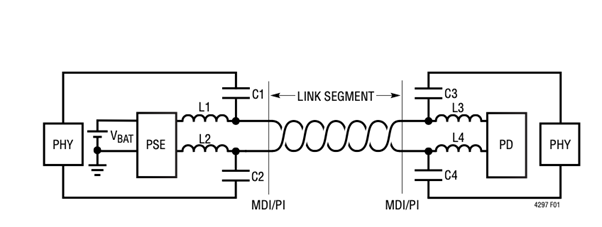 Figure 2: Basic PoDL circuit architecture. (Source: Analog Devices)
Figure 2: Basic PoDL circuit architecture. (Source: Analog Devices)
Before power is applied, the PSE and the PD exchange a small amount of information, and this handshaking process enables them to determine if their voltage and power requirements are compatible. The PSE does not apply full voltage until a compatiblePD is connected and removes full voltage quickly when the PD is disconnected, or if a fault is detected.
Implementing SPoE
To illustrate how to architect an SPoE OT application, let’s use the example of a system based around two controllers from Analog Devices: the LTC4296-1 five-port SPoE PSE controller and the LTC9111 industrial SPoE PD controller.
Analog Devices was first in the market with IEEE 802.3cg-compliant PSE and PD SPoE solutions. It offers a complete solution of PHY, PSE and PD, with IEEE 802.3cg compliance to ensure interoperability. Functions provided include classification, and fault and disconnect detection.
The LTC4296-1 (Figure 3) is designed for interoperability with 802.3cg PDs in 24V or 54V systems, and it controls and monitors power delivery for up to five point-to-point PDs. It provides a versatile PSE solution for 10BASE-T1L controllers and switches and can easily be integrated with Analog Devices’ 10BASE-T1L transceiver portfolio, such as the ADIN1100 PHY, ADIN1110 MAC-PHY, and ADIN2111 two-port switch.
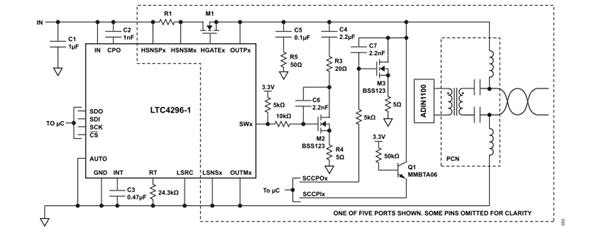
Figure 3: Typical Analog Devices LTC4296-1 circuit (Note: Only one of the five ports is shown). (Source: Analog Devices)
The LTC9111 (Figure 4) is the world’s first IEEE 802.3cg compliant PD controller. It has a wide 2.3V to 60V operating range capability with polarity correction, which makes it well-suited for classification-based systems in building and factory automation.
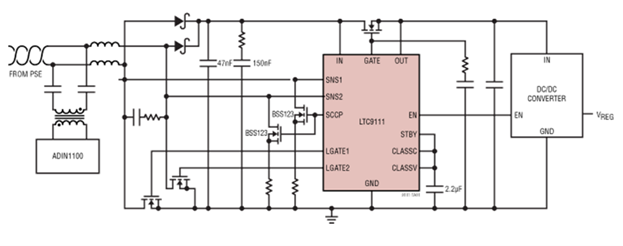
Figure 4: Analog Devices LTC9111 application circuit. (Source: Analog Devices)
To request power, the LTC9111 presents a valid class to the PSE. The application circuit of the LTC9111 uses external MOSFETs to minimise power loss, optimise system cost, and improve fault tolerance.
Analog Devices also offers the EVAL-SPoE-KIT-AZ evaluation kit (Figure 5), which helps engineering teams tasked with prototyping a SPoE PSE/PD design by simplifying development and cutting time to market.
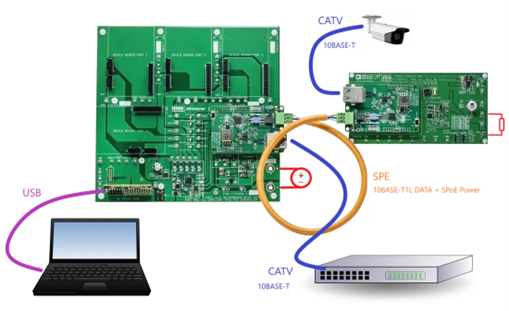
Figure 5: Board setup for the Analog Devices EVAL-SPoE-KIT-AZ evaluation kit. (Source: Mouser Electronics)
The evaluation kit features both the LTC4296-1 and the LTC9111, as well as the necessary cables and interfaces. The Analog Devices ADIN1100 10BASE-T1L PHY provides the Ethernet data in the system.
Reliable, efficient networking using SPE and SPoE
SPE brings the benefits of Ethernet to OT, industrial, and automotive applications, providing reliable, efficient networking at megabit speeds. With interoperability ensured by 802.3cg and other IEEE standards, it is fast becoming the communications technology of choice across many industries that previously would have relied on a mix of legacy networks.
By enabling power to be sent over the twisted pair data cables, SPoE simplifies the installation of SPE networks and makes them cheaper and faster to implement. This is particularly useful where space and weight are constrained.
For engineers looking to design SPE and SPoE into their systems, evaluation kits such as the Analog Devices EVAL-SPoE-KIT-AZ provide a straightforward way to get up and running quickly.







